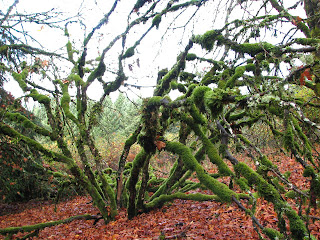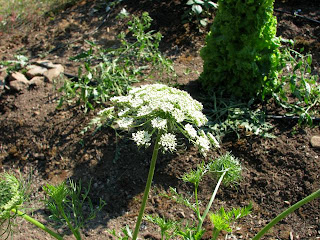Some people probably wonder "Why Reluctant Homesteaders?" I have recently realized that it seems so petty and ungrateful if you don't know the whole story. We are fully aware that many people would give their eye teeth to be in our position. We
are thankful, but we are not certain we are qualified for the job of Homesteaders.
Buck has talked about
part of the reason for our reluctance. We have another small home (where my father lives now) that we love very much and had been planning to live there 'till we died. It has just enough land to have a few animals and is the original farm for the area so it is on the edge of a small town. The perfect mix.
Well, as things worked out, a few untimely and tragic deaths in the family, created a situation in which we inherited the dilapidated family farm and we had to choose, at the lowest point of the recession, whether to save it or sell it. We couldn't bring ourselves to sell it, so here we are trying to save it. We're grateful for the opportunity and the beauty of it all, but in the mix are ambivalent feelings about our ability to afford it, work it and live it.
On this Day of Thanks I bring before you the perfect illustration of why we are "Reluctant".
The Story of Gimpy McGimperson.
Once upon a time, Phoebe and Buck started thinking, in the way that people who have been trying for a while to eat local and be mindful of where their food comes from, about raising their own beef. Buck was pretty sure he could raise a cow and not become attached. Phoebe, on the other hand, grew up on a farm and knew how hard it is to not get attached.
To test the waters Phoebe ordered five Bourbon Red turkey poults. "We will raise them and eat them for the holidays," she announced to all the family. All the while knowing, deep in her heart, it was doomed from the beginning.
It turns out that the poults need a lot of attention because, despite the insistence that heritage breeds are smart, they are not smart in the way you would like them to be. They do not feed themselves by foraging, as "free range" turkeys should. They merely wander about, thinking "What is that Shiny thing?" Then one will grab up a piece of rope or gum wrapper or tin can label that has blown out of the recycling and run as fast as it can all around the orchard with the other four in hot pursuit. When this futile attempt at foraging ends and they have burned off a few thousand calories and toned and strengthened their fine turkey glutes, they meet in a cluster and express their opinions in loud whistles and clucks.
When some agreement has been reached, they all head to the front gate where they can stare into the kitchen window, for they know (and this is where the "smart" comes in) if they cry at the gate loud enough, the Nice Man in the Plaid Coat will feed them yummy crumbles.
The Nice Man tends to them, but grows resentful. They don't seem to be getting any better at feeding themselves. They grow taller but not fatter and they are getting bossier and more demanding.
The Wild Free Range Turkeys take to hanging at the top of the hill like a gang of teenage thugs. They whistle and cluck in a Supersonic, ear piercing language that sounds much more like aliens communicating than poultry. They invent the fun game of pecking at the small neighbor children as they stroll down our lane. They cherish the moments when they can corner the poor old farm dog and peck at her Shiny, frightened, yummy looking eyes.
About this time the pack leader, because at this point they have become a truly terrifying, marauding pack, discovers a singularly marvelous thing! If one flaps the appendages at one's sides they will, very nearly, levitate one to the hood of the Shiny car. But not quite. A bit of wild, sharp clawed scrabbling along the fenders is needed to get
all the way up. All the more fun. Then one can lounge about all day long on the Throne of Shininess and pick at one's feathers and relieve oneself into the window vents.
Now a whole new world is theirs to conquer! There are roof racks to perch upon, wood sheds full of wood to cover in poop, farm dogs who will
never outrun a flying foe! All the while they sing the Supersonic cry of the Wild World Ruling Free Range Turkey!
Then one fateful day the WWRFRT's decide to explore the proverbial "other side of the fence".
They have a super good time eating every single one of Buck's raspberries, but then one WWRFRT does not make it all the way back over the fence. Phoebe does not know this. The Nice Man in the Plaid Coat does not know this. The WWRFRT's know this.
Phoebe does not understand that the WWRFRT's she finds on the Forbidden Deck, Supersonic peeping into the kitchen door, are trying to TELL HER SOMETHING!!!! She shakes a tea towel at them and scares them away.
The next day the Nice Man in the plaid coat notices there is one less WWRFRT. He does not feel particularly sad and feels a little guilty about that. The WWRFRT's are more clingy than usual but he puts them off and does his chores. But then Nice Man sees him, a fallen soldier, dangling upside down from the back fence.
Instantly the Nice Man in the Plaid Coat feels sorry for ignoring their turkey pleadings. He feels ashamed for being glad a coyote had eaten the turkey. He feels appalled at the poor turkey's suffering.
The Nice Man in the Plaid Coat untangles the young turkey's leg and sees how mangled it is. The foot is black and swollen, the leg deeply cut and broken.
He carries the young turkey to the house, flanked by it's peeping and lurching comrades.
Inside, Phoebe is having her morning tea. She does not know that there has been a Turkey Tragedy. She does not know that she is about to learn what the WWRFRT's were trying to tell her.
The Nice Man in the Plaid Coat comes to her in the kitchen, bearing the turkey who will soon be named Gimpy McGimperson.
She now takes in the sad look on her father, the Nice Man's face, she flashes back to the turkey whistles on the Forbidden Deck and grimaces at the black, dangling foot of the turkey before her and, and, and.... springs into action!
She gets out the triple antibiotic ointment. She deftly fashions a splint from a piece of plastic hose and a bit of chamois. The Nice Man speaks soothingly to the pale, shocked turkey. Like a professional Turkey Surgeon, Phoebe sets the bone, applies the splint and tapes it in place.
Days pass, weeks pass and the WWRFRT's keep watch for their friend, their brother, to recover and return to them. And when that day finally arrives they are so overjoyed to see him that they MUST PECK HIS EYES OUT and he has to be put back into the safety of his dog kennel.
Now, while Gimpy McGimperson was in hospital, the WWRFRT's did spend a great deal of time on the front gate gazing into the kitchen window and running alongside of Nice Man asking a myriad of questions about Gimpy: "Is he fatter than me?" "Will his foot fall off and make him slow?" "Are his eyes Shiny?" They also were sure to make time to loiter in front of the Postal truck, chase the lady neighbor's Pomeranian and other important duties which cannot just be ignored with impunity.
Around the time of Gimpy's failed release, Phoebe begins to realize that there is about a thousand dollars worth of scratches on the fenders of the cars and is sick of driving around town with a couple of ice cream scoops worth of turkey poop on the hood.
The WWRFRT"S are curious when Phoebe comes to take their picture. Oh and maybe they could get to her Shiny eyes while she is bending down and distracted.
Phoebe posts their pictures on Craig's List and describes them as they were described to her, back before she knew better. "Almost grown, heritage breed turkeys. Free Range and intelligent. Will be ready for the holidays." And when Buck loads them into the Young Couple's car the next morning it is difficult to tell who is happier, the Young Couple or the Nice Man in the Plaid Coat. Phoebe knows who will
stay happy and it is not the Young Couple.
Of course this is not the end of the story. There is the curious promotion of Mr. Gimpy McGimperson. Once thought to be the dumbest WWRFRT, he has now proven to have been the very smartest of them all. He has garnered the lifelong companionship of the Nice Man in the Plaid Coat and is, this very day, witnessing the celebration of his first Thanksgiving in which he is
not on the table.
Mr. Gimpy McGimperson found out that to live happily ever after he did not need the President of the United States to pardon him and keep him from being eaten, no, he only needed to go live with the Reluctant Homesteaders.



















































